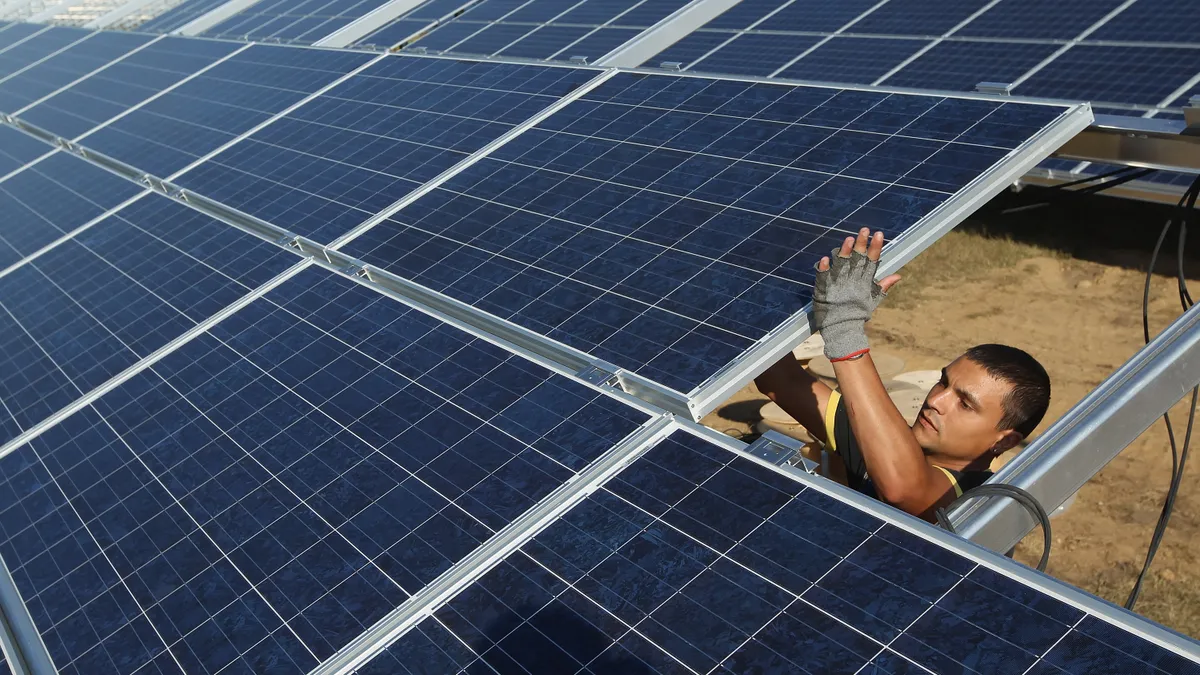Dive Brief:
-
The U.S. solar industry deployed a record 23.6 GW of generating capacity in 2021, representing 46% of new electrical generation added last year, according to the 2021 U.S. Solar Market Insight by Wood Mackenzie and the Solar Energy Industries Association.
-
Utility-scale projects represented 17 GW of the solar installed in 2021 — more than twice the capacity installed just two years prior. However, utility-scale installations came in 3 GW lower than expected.
- Multiple projects were delayed, particularly in the fourth quarter of last year, in light of cost increases of up to 18%, according to the report, raising questions about whether another year of record installations is possible in 2022 after 13% of the year's planned installations were delayed.
Dive Insight:
That the U.S. solar industry installed a record number of solar capacity in 2021 is no particular surprise — solar has set new records almost every year for the last half-decade. But new economic challenges may break the industry’s growth streak next year.
One-third of utility-scale solar projects scheduled for completion in the final months of 2021 have been delayed by at least a quarter, and 13% of 2022 installations have been delayed a year or more on account of price increases caused by supply chain challenges, trade actions and legislative uncertainty, according to the Wood Mackenzie and SEIA report published on Thursday. Current projections now call for the installation of 21.9 GW of energy additions in 2022, compared to 23.6 GW installed in 2021 and down from the 25.5 GW Wood Mackenzie anticipated would be installed in 2022 prior to 2021, according to SEIA.
“The supply chain constraints of the last year will hit 2022 installations the hardest, reducing capacity by 7% compared to 2021,” Michelle Davis, principal analyst at Wood Mackenzie and lead author of the report, said in a statement. Wood Mackenzie anticipates that the industry’s growth will continue after 2022.
Utility-scale solar has borne the brunt of the headwinds so far, facing cost increases of up to 18% for fixed-tilt projects and 14.2% for single-axis tracking projects during the fourth quarter of 2021, according to the report. But commercial solar installations also stagnated, with new capacity nearly equal to 2020 at 1.4 GW, due to interconnection delays and supply chain constraints. Community solar posted 7% year-over-year growth, while residential solar installations grew 30%. Nearly 5% of U.S. owner-occupied homes now have rooftop solar, according to the report.
But SEIA fears residential momentum could slow as a result of proposals in both California and Florida, which would cut into demand for rooftop solar by reducing compensation under their net metering programs. California and Florida were the top two states for residential solar installations in 2021, according to the solar insight report.
SEIA also argues that a long-term extension of the federal solar Investment Tax Credit could help alleviate current pressures.
Wood Mackenzie projects that extending the Investment Tax Credit would increase utility-scale solar deployments by 86%, while residential installations would grow by 20% and commercial and community solar by 15%. Solar capacity additions would exceed 70 GW per year by 2030 in this scenario, while without the tax credit Wood Mackenzie’s numbers show that new solar installations would be limited to 39% of what’s necessary to reach the Biden administration’s decarbonization goals, according to SEIA.
“In the face of global supply uncertainty, we must ramp up clean energy production and eliminate our reliance on hostile nations for our energy needs,” SEIA CEO and president Abigail Ross Hopper said in a statement. “Policymakers have the answers right in front of them: if we pass a long-term extension of the solar Investment Tax Credit and invest in U.S. manufacturing, solar installations will increase by 66% over the next decade, and our nation will be safer because of it. America’s energy independence relies on our ability to deploy solar, and the opportunity before us has never been more obvious or urgent.”












